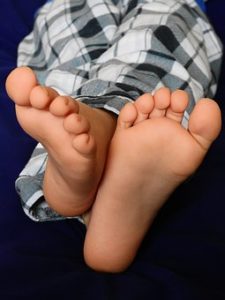 The plantar fascia is vital for normal foot biomechanics. It is made up of three segments and its central portion is clinically most important as it forms the longitudinal arch of the foot. It not only provides the longitudinal arch with static support but provides dynamic shock absorption. Plantar fasciitis is an overuse condition of the plantar fascia at its attachment to the calcaneus.
The plantar fascia is vital for normal foot biomechanics. It is made up of three segments and its central portion is clinically most important as it forms the longitudinal arch of the foot. It not only provides the longitudinal arch with static support but provides dynamic shock absorption. Plantar fasciitis is an overuse condition of the plantar fascia at its attachment to the calcaneus.
Who is at risk of developing Plantar Fasciitis?
– Low arches (flat feet)
– High arches
– Activities that require simultaneous maximal plantarflexion and metatarsal joint dorsiflexion (such as running or dancing)
– Excessive walking in non-supportive footwear
– Reduced ankle dorsiflexion
– Increased BMI
– Obesity
– Work-related weight-bearing
– Tightness in calf, hamstring and gluteal muscles
– Hip muscle strength imbalances
What are the symptoms?
– Usually a gradual onset of pain is reported
– Symptoms typically felt on the medial aspect of the heel
– Increase in pain is felt after periods of inactivity/rest
– Initially pain is worse in the morning, and gets better with activity
– In more severe cases, weight-bearing can be painful and increase pain with activity
What are the signs?
– Acute tenderness/pain along the inside of the heel bone and inside arch of the foot
– Stretching of the plantar fascia may be painful
– Excessive pronation or supination on gait assessment
– Weakness in intrinsic foot musculature (small foot muscles), Tibialis Posterior, Calf and Hip Abductor muscles
Investigations: Investigations are not always needed as the diagnosis can often be made from the signs and symptoms and through a thorough clinical examination.
– Ultrasound – can show swelling of the plantar fascia or thickness of the fascia
– X-rays – can show a calcaneal spur, however, spurs are not causally related to pain.
What are my treatment options?
Short Term:
– Avoid aggravating activities, such as walking, stairs
– Ice after activity to settle pain
– Stretching and soft tissue massage of the plantar fascia, gastrocnemius and soleus muscles
-Mobilisation of the foot and ankle joints
– Self massage with a frozen water bottle or golf ball
– Non-steroidal anti-inflammatory drugs (NSAIDS) may be rpescribed
– Taping (e.g. taping the foot into inversion or low-dye taping)
– Silicone gel heel pad
– Corticosteroid injection may be an option if required (in combination with other treatments)
Long Term:
– Strengthening exercises – including the intrinsic muscles of the foot and proximal muscle groups (e.g. Tibialis Posterior and hip abductors/external rotators)
– Motor control re-education and technique modification to avoid recurrence
– Supportive footwear to support the arch
– Biomechanical correction with orthoses if required
– Soft tissue therapy – including the plantar fascia, calf, hamstring and gluteals
If you are having symptoms of Plantar Fasciitis or heel pain come and see one of the Physio’s at Sydney CBD’s Bend + Mend. We can help diagnose and manage your foot pain!





